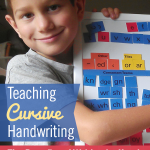
Is learning cursive still relevant?
In an era of keyboards, tablets and smartphones, is learning cursive writing still relevant? Common Core standards for public school do not require cursive writing instruction for elementary students. On the other hand, some states have rallied against this changing tide, arguing that cursive writing is necessary for students to be able to read historic documents and to produce a legible signature. In fact, 14 states have passed laws requiring cursive proficiency in public schools.
So I ask myself, as perhaps you do, what approach should we take in our homeschooling? Is it time to write off cursive as a relic of the past or does learning handwriting—and cursive specifically—have benefits we would miss? Should we be teaching cursive handwriting to our children?
The Benefits of Writing by Hand
As I have reviewed what scientists and educators have had to say about this question, some are pointing to surprising benefits of writing by hand.
In her NY Times article What's Lost as Handwriting Fades, Maria Konnikova says: “Children not only learn to read more quickly when they first learn to write by hand, but they also remain better able to generate ideas and retain information. In other words, it’s not just what we write that matters — but how.”
Dr. William Klemm says in Psychology Today that “Cursive writing helps train the brain to integrate visual, and tactile information, and fine motor dexterity."
I recently found this article Ten reasons people still need to learn cursive quite persuasive. I encourage you to read the full article, for I was struck by the ways handwriting helps children learn. Let me share a few highlights from it with you. Perhaps you can be encouraged, as I was, regarding some of the benefits of the handwriting instruction you likely already provide your children.
1. Brain Connections from Cursive Handwriting
Cursive coordinates right and left brain connections in ways that typing and printing do not. This encourages different parts of the brain to "talk to each other" and carries similar brain benefits to that of playing a musical instrument.
According to Dr. Virginia Berlinger, "When we write by hand, we have to execute sequential strokes to form a letter—something that brain scans shows activate the regions involved in thinking, language, and working memory. Cursive accelerates the benefits."
2. Multilingual by Hand
Children should be "multilingual by hand." Because printing, typing, and cursive writing each light up different parts of the brain, Dr. Berlinger states that children should be "multilingual by hand" and learn all three.
3. Handwriting as Foundation for Letter Recognition
Handwriting helps kids learn their letters more effectively than keyboarding or sight recognition alone by using both the hand and the brain (fine motor with cognitive recognition).
The process of hitting a key to type the letter B on a keyboard is the same process as hitting a key to type the letter T. But the strokes involved in writing by hand are unique. Dr. William Klemm says, “Cursive writing, compared to printing, is even more beneficial because the movement tasks are more demanding, the letters are less stereotypical, and the visual recognition requirements create a broader repertoire of letter representation.”
4. Special Needs Learners and Cursive Handwriting
Cursive writing practice may help kids with special needs. The exercise of cursive writing may improve language fluency for students with dyslexia or dysgraphia because of the fluid motion and connected letters.
Beyond the skill of writing, it seems that even the process and motion of writing can actually help children learn more effectively, organize ideas, and remember what they have learned.
“When we write, a unique neural circuit is automatically activated,” said Stanislas Dehaene, a psychologist at the Collège de France in Paris. “There is a core recognition of the gesture in the written word, a sort of recognition by mental simulation in your brain. And it seems that this circuit is contributing in unique ways we didn’t realize. Learning is made easier."
Forming Letters and Shaping Brains with Cursive Handwriting
As you help your children learn cursive, you are not only connecting them to their history (from the ability to read their grandparents’ letters to the Declaration of Independence), you are also helping them integrate their learning, absorb information, and process their thoughts. You are helping their dexterity and aiding brain connections they need to form letters and to form ideas. And you can reap those benefits from the simple handwriting resources scheduled for you by Sonlight. Perhaps some of these hidden benefits of learning handwriting will give you confidence that you are doing everything you can to help your children thrive.








Thank you! I certainly agree that writing by hand is very useful for developing creative thinking and cognitive skills. And I believe that a child should learn to write by hand as early as possible. But I also support the fact that all this is individual, and there are some children who are easier to print, in which case you should not be too demanding of them. Here is a "question and answer" dedicated to this topic, which explains the situation well: https://writeshop.com/type-or-write-by-hand/ It also describes in more detail the benefits of handwriting and typing as useful skills.
I like to give writing lessons, we have many templates and workbooks for calligraphy. But at the same time, sometimes children also type text on the tablet. But I will be glad if handwritten notes become their preferred option in the future.